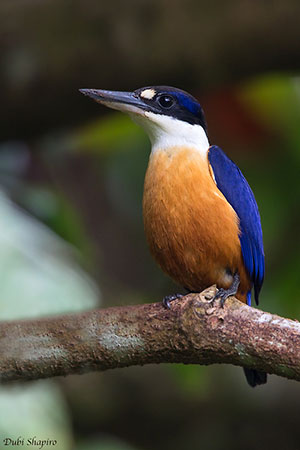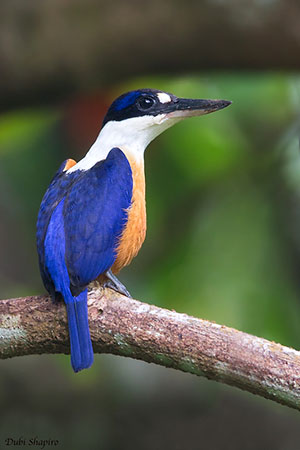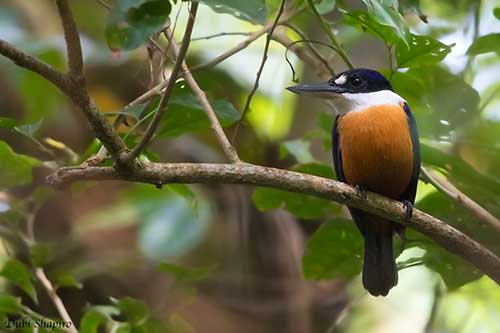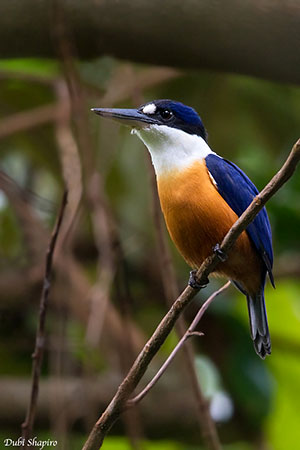
Fr: Martin-chasseur à ventre roux
Ang: Vanuatu Kingfisher
All: Braunbauchliest
Esp: Alción Ventrirrufo
Ita: Martin pescatore panciacastana
Nd: Kastanjebuikijsvogel
Sd: vanuatukungsfiskare
Photographer:
Dubi Shapiro
Dubi Shapiro Photo Galleries & Dubi Shapiro's Pictures on IBC
Text by Nicole Bouglouan
Sources:
HANDBOOK OF THE BIRDS OF THE WORLD Vol 6 by Josep del Hoyo-Andrew Elliott-Jordi Sargatal - Lynx Edicions, 2001 - ISBN: 848733430X
Birds of Melanesia: Bismarcks, Solomons, Vanuatu and New Caledonia Par Guy Dutson – Editeur : Bloomsbury Publishing, 2011 – ISBN: 1408152460, 9781408152461
Kingfishers, Bee-eaters and Rollers Par C. Hilary Fry, Kathie Fry – Editeur: A& C Black, 2010 – ISBN: 1408134578, 9781408134573 – 344 pages
Wikipedia, the free encyclopaedia
Vanuatu Kingfisher
Todiramphus farquhari
Coraciiformes Order – Alcedinidae Family
INTRODUCTION:
The Vanuatu Kingfisher is endemic to Vanuatu where it occurs on some islands of the archipelago. It frequents mainly the primary forest from lowlands to at least 700 metres of elevation. It feeds on insects, spiders and small lizards, and often hunts from perch. It nests in holes in palm trees or excavates a hole in arboreal termite mound.
The Vanuatu Kingfisher is fairly common in suitable habitat, but the species is threatened by forest clearance and habitat degradation by cattle and pigs. It is currently listed as Near Threatened.

DESCRIPTION OF THE BIRD:
Biometrics:
Length: 21 cm
Weight: M: 32-42 g – F: 35-42 g
The Vanuatu Kingfisher adult male has dark blue back, wings and tail, but the rump is paler blue. The flight-feathers are blacker. Hindneck and upper mantle are white.
On the underparts, chin and throat are white. The breast is bright orange, becoming orange-rufous on belly, undertail-coverts and underwing-coverts.
On the head, crown and forehead are dark blue with large rounded whitish supraloral spot. It is bordered by a deep dark blue band extending from eye to nape. Lores, ear-coverts and upper cheeks are black, extending backwards to form a black collar around the nape, contrasting strongly with the white hindneck.
The long bill has black upper mandible and pale horn lower mandible with black tip. The eyes are dark brown. Legs and feet are greyish-black.
The adult female resembles male but she has white lower belly.
The juvenile is duller, with the white areas of head and neck tinged rufous.
RANGE:
The Vanuatu Kingfisher occurs in NC Vanuatu on Espiritu Santo, Aore, Malo and Malekula Islands.

HABITAT:
The Vanuatu Kingfisher frequents shaded, undisturbed forest from lowlands up to 700 metres of elevation at least. It is more often seen in hills. It may occur in dense secondary regrowth, but also in gardens, farmland and coconut plantations on Malo Island.
CALLS AND SONGS: SOUNDS BY XENO-CANTO
The Vanuatu Kingfisher gives long, accelerating series of short-sharp “teek” repeated several times (up to 20) or for more than a minute. It becomes faster and rises in pitch.
The alarm call is a harsh “cach cach” given by the bird while jerking head and tail.
BEHAVIOUR IN THE WILD:
The Vanuatu Kingfisher feeds on insects such as grasshoppers, ants, moths and beetles. It also takes spiders and small lizards.
It hunts from perch, sitting quietly high in canopy while scanning for prey. The prey is often caught in flight, but also in foliage, on branches and tree trunks. It also forages on the ground and probes into the leaf litter with its long bill while searching for insects.
The Vanuatu Kingfisher lives year-round in monogamous pair. They are territorial, but any territorial or visual display had been observed. It nests in tree holes or in termite mounds in trees.

The Vanuatu Kingfisher is probably sedentary, and only moves over short distances to exploit rich food sources.
The flight is agile and it may hover while hunting insects.
REPRODUCTION OF THIS SPECIES:
The laying occurs in December on Espiritu Santo.
The pair excavates a nesting hole in arboreal termite mound, or uses a tree hole in palm-tree or tree-fern.
The female lays three eggs. No more information.
PROTECTION / THREATS / STATUS:
The Vanuatu Kingfisher has restricted range on some islands in Vanuatu. On Espiritu Santo, it is affected by habitat loss through logging for expansion of cattle pastures. The same problem probably occurs on Malekula and Malo. Degradation of primary forest by cattle and pigs also affects this understorey species.
The population is roughly estimated to number 6,700 mature individuals, and is slowly declining.
The Vanuatu Kingfisher is currently listed as Near Threatened.
